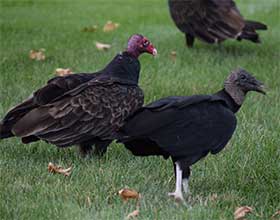 It’s November, and Ohio’s migratory summer-breeding birds have left the state. That list of migrants includes the turkey vulture, which, as recently as a few decades ago, was southwest Ohio’s only vulture species. November used to be the beginning of the “vulture-free” time of year for Greene and Montgomery Counties. Not anymore.
It’s November, and Ohio’s migratory summer-breeding birds have left the state. That list of migrants includes the turkey vulture, which, as recently as a few decades ago, was southwest Ohio’s only vulture species. November used to be the beginning of the “vulture-free” time of year for Greene and Montgomery Counties. Not anymore.
Historically, turkey vultures, Cathartes auratus, were widespread across Ohio. They bred in counties across the state during warmer months but mostly migrated south in the fall. (In northeastern Ohio, the springtime return of those birds is celebrated each year in Hinckley on 15 March as Buzzard Day.) A second vulture species, the black vulture Coragyps atratus, also has a long record in Ohio, but restricted to the unglaciated southeastern counties. Though less migratory than turkey vultures, black vultures typically moved a bit southward for winter. The 1984 book The Birds of Dayton by the Dayton Audubon Society lists the black vulture as a “very rare visitor” to the Miami Valley and notes that this species “doesn’t seem to wander into the Montgomery County area.”
In recent years, those scenarios have changed. According to eBird, the public database of bird sightings with more than 1 billion logged observations, turkey vultures are now observed year-round — though still somewhat less so in winter — in both Montgomery and Greene Counties. (Check out the “explore/bar charts” link at ebird.org.) Black vultures, too, though generally less common than turkey vultures, now produce a steady stream of local reports in every month of the year, with no apparent cycle of abundance.
Both turkey and black vultures feed primarily on carrion, though black vultures are the more aggressive species and may be more likely to seek live prey. The two species are often seen together, both in flight and while feeding on the ground. While both appear as large, black birds, they do have distinguishing features. The larger turkey vulture has a red head as an adult (gray in juveniles) and solid black wings that are held in a noticeable “V” configuration in flight. In contrast, black vultures have gray heads and in flight hold their wings more horizontally, showing off distinct white patches toward the wingtips. In a mixed feeding group, black vultures tend to dominate, with turkey vultures taking a more peripheral position around the carcass.
What accounts for the changing abundances of the two vulture species in southwest Ohio? Two factors are likely important for both species. The first is the increase in human impact on the landscape. Both the increase in road-killed animals from vehicular traffic, as well as an increase in domestic carcasses as agriculture expands, are enhancing the food supply for vultures. (At the same time, cars pose a significant risk to vultures feeding on roadkill.) The second factor is also human-generated, though less direct. That is, climate change is creating warmer winters, which supports the notable increase in year-round residency for Ohio’s vultures.
One additional factor — a difference between the species — may be significantly responsible for the northward and wintertime expansion of black vultures. It turns out that among birds, turkey vultures have one of the best-developed senses of smell. Rotting corpses emit sulphur-containing ethyl mercaptan, and turkey vultures can follow that odor to its source. (Ethyl mercaptan is also added to commercial natural gas to facilitate leak detection. Humans can detect leaks at home, but vultures can be used as an indicator of leaks in supply lines.)
Black vultures, though related to turkey vultures, lack their olfactory capabilities. That difference is reflected in their anatomy. Turkey vulture brains are 20% smaller than black vulture brains. However, the brain structure responsible for processing the sense of smell — the olfactory bulb — is four times larger in turkey vultures. They also have more mitral cells, which relay olfactory information to the higher brain, and larger nasal cavity surface area. The result is an elevated sense of smell.
A consequence of that sensory disparity is that turkey vultures have an advantage in locating carcasses, even those that are visually concealed. And so black vultures do the next best thing and follow turkey vultures, often flying higher than their larger cousins so they can watch from above.
In the scheme of ecological communities, scavengers are critical contributors, as they remove dead organisms from and recycle organic matter to the landscape. This November, perhaps you will be giving thanks for the turkey providing sustenance to your family. At the same time, those other large birds with bald heads — the turkey vulture and its black vulture cousin — might warrant a moment of appreciation, too.
Article and photo contributed by Dr. David L. Goldstein, Emeritus Professor, Department of Biological Sciences, Wright State University.
